If you have a cat giving birth for the first time soon, you’re likely filled with a range of emotions. Excitement to meet and hold the new tiny kittens. Concern about what you should be doing to support the mama cat. Fear that something could go wrong with the birth. Knowing what to do when a cat is giving birth can help prepare you for the big event and help make sure you’re ready to step in when needed.
Table of Contents
- Signs That a Cat is in Labor
- What do I do when my cat gives birth for the first time?
- Cats Will Tell You if They Need Help
- The First Birth May Take Longer
- If Your Cat is Straining for a Long Time, Get Help
- Don’t Be Shocked with What Your Cat Does After Birthing the Kittens
- Don’t Get in the Way of Mama Bonding with Her Kittens
- Keep the Kittens Close to their Mother During their Early Life
- How to Prepare When Your Cat is Pregnant
- Cat Giving Birth for the First Time? Stay Calm; It’ll Be OK!
- FAQs
Signs That a Cat is in Labor
Before we get into what you should or shouldn’t be doing if your cat is in labor, let’s discuss how to tell when your cat is in labor.
First, it is important to note that the length of a cat’s pregnancy is typically about 9 weeks (between 64 and 67 days). However, if you don’t know the actual day that she conceived her kittens, you may still be having a difficult time deciding whether your cat is in labor yet.
Below are some signs that most cats will display when they are in labor and getting ready to deliver their kittens.
Nesting Behaviors
If you or someone you know has given birth, you probably already know that humans start ‘nesting’ or preparing for the baby before they arrive. Cats do the same and want to make sure they are ready for the arrival of their kittens.
To support your soon-to-be mama cat with this, prepare a kittening box for her. Line the base of the box with newspaper, then add washable blankets or other bedding over the newspaper to create a soft and comfortable spot for her to lay when she gives birth.
Decrease in Temperatures
The normal temperature of a cat is higher than ours (typically ranging between 100 ºF and 102.5 ºF). However, a few days before your cat is ready to give birth to her kittens, her temperature will drop a few degrees (to around 99 ºF).
Monitoring your cat’s temperature can help you identify when she is getting close to bringing her kittens into the world.
Increase in Size of Mammary Glands
The mammary glands of a female cat will also increase in size as she’s preparing to give birth. It is normal to notice secretions that are white or cream-colored coming out of the nipples.
Loss of Appetite
In the weeks leading up to pregnancy, you may notice that your cat seems to have an increased appetite and be looking for more food. However, right before giving birth, your cat’s appetite may decrease quite a bit.
In some cases, this decreased appetite is caused by the cat’s anxiety about preparing to give birth, while at other times it may be because the kittens weigh a lot more now and are pressing against her stomach.
Changes in Behavior
A cat’s behavior will also often change towards the end of her pregnancy.
Some cats may act more affectionate and look for extra attention from their owners (or favorite owner). These cats are often the ones that will want this owner nearby when they are giving birth.
Other cats may isolate themselves more from others in the home. They are signaling that they want to be left alone and will likely manage labor mostly on their own.
You may also notice your cat licking at her genitals more frequently. This is likely caused by discharge from the vulva—a sign that labor is imminent.
Cats may also start acting restless, meowing, howling, or chirping as they are nearing labor and delivery.
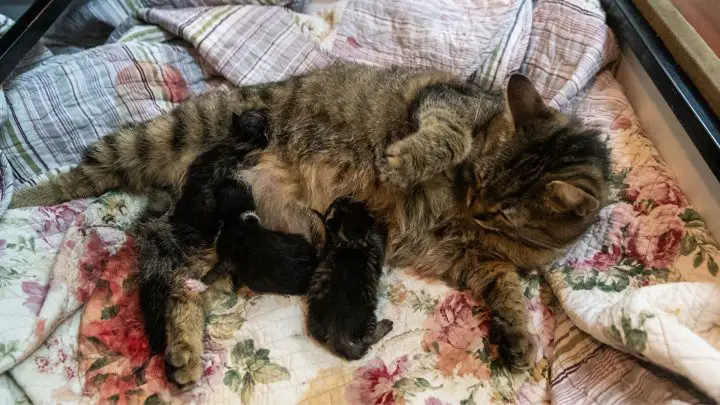
What do I do when my cat gives birth for the first time?
Now that you know some of the signs to look for, what are you supposed to do when your cat goes into labor?
The most important thing is to remember that mama cats, or queens, have good maternal instincts. Follow their guidance, and everything should be fine.
Below are some essential things to know about a cat giving birth for the first time. Read through these to cover all the basics regarding what will be happening during the birthing process and what your roll should and shouldn’t look like.
Cats Will Tell You if They Need Help
Follow your cat’s lead; in most cases, they will let you know if and when they need help.
Many queens will look to give birth in a quiet and isolated spot in the house. Having a kittening box ready for your cat, as described above, can help provide this safe spot she desires. However, if your cat seems interested in giving birth in another location, let her have the final say.
In some cases, your cat may want you to be more involved in the birthing process. If you hear her howling or meowing a lot, it may be her way of calling you in to assist.
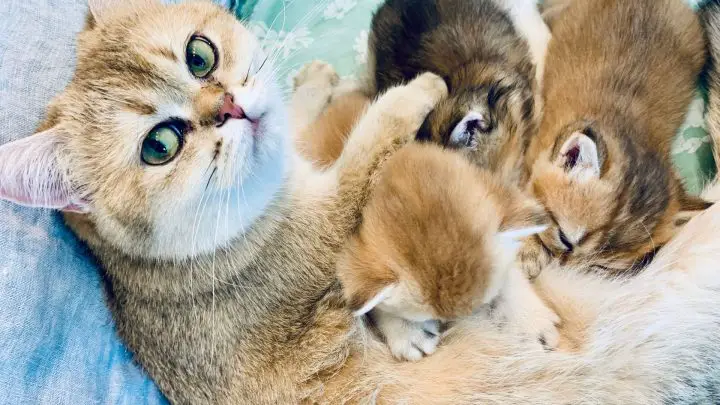
The First Birth May Take Longer
How long are cats in labor for the first time? The first birth is typically the longest for cats and may last 36 hours or longer. Expect to wait at least 20 minutes to 1 hour between the birth of each kitten, if not longer.
If you notice cat giving birth for the first time interrupted labor, don’t be too concerned. Some queens will stop to rest longer between kittens or may pause to tend to the needs of the kittens that have already been born.
If Your Cat is Straining for a Long Time, Get Help
The first litter of kittens typically has two to three cats. If you notice that the mother cat is still straining after giving birth to three kittens (or more), it could mean something is wrong. The placenta may be undelivered, or there could potentially be another kitten that she is having trouble delivering.
In any case, if you are concerned and feel that something isn’t right, contact your veterinarian. They may need to take out the placenta to help end labor. They can also assist if there is another kitten or if there are any other complications.
Don’t Be Shocked with What Your Cat Does After Birthing the Kittens
It may sound strange, or even disgusting, but after a cat gives birth, they will eat the placenta, amniotic sac, and umbilical cord. This is part of the birthing process, and is completely normal.
The mother cat is starting to care for her kittens. This is also their instincts kicking in to clean up any evidence of birth to protect the new kittens from potential predators in the wild.
Don’t Get in the Way of Mama Bonding with Her Kittens
The mother cat and her baby kittens will need to bond without interference from you.
Following birth, don’t try to hold the kittens or move them. They need to stay close to their mother to feed and stay warm.
Unless you sense any danger to the kittens, standing back and watching is the best course of action.
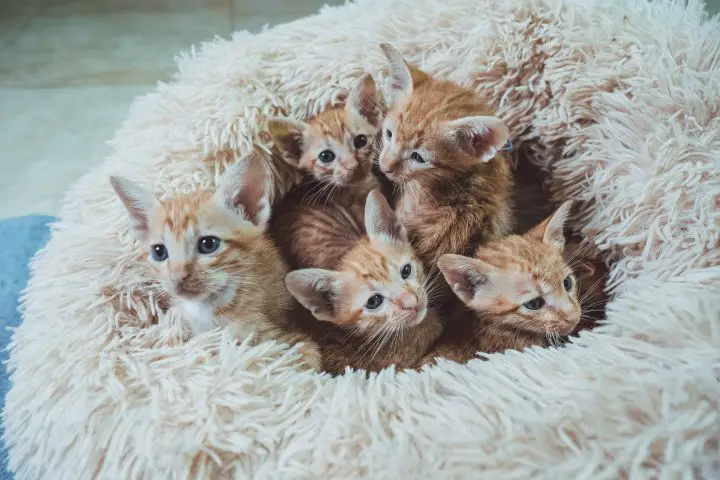
Keep the Kittens Close to their Mother During their Early Life
Keeping the kittens close to the mom is important for more than just bonding. The kittens need their mother to take care of them. If you’re planning on putting the kittens up for adoption, try to wait at least 12 weeks.
If your cat giving birth for the first time and not taking care of them, you will need to step in. Newborn kittens are not able to regulate their body temperature. If the mother cat doesn’t dry off her kittens as soon as they are born, carefully dry them off with a clean and soft cloth to prevent their body temperature from dropping too low. Likewise, if the mother continues to ignore the kittens and isn’t keeping them warm, place a heating pad under the bedding to make sure they don’t get too cold. If it doesn’t appear that the mother cat is willing or able to take care of her babies, reach out to the veterinarian for further advice.
During these early weeks of their life, they will rely on their mother for food and warmth. Once the kittens are between 6 and 8 weeks old, they can be weaned off of their mother’s milk. Talk with your vet to make sure you are feeding the cats enough calories each day to help them stay healthy.
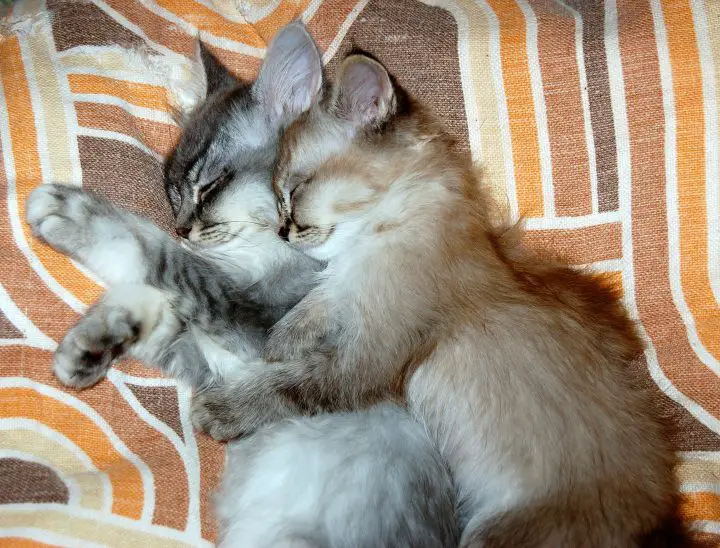
How to Prepare When Your Cat is Pregnant
Once you learn that your cat is pregnant, there are a few things you can do to start preparing for the new kittens.
These include:
- Choose the right food: Once your cat enters the third trimester, switch her to a canned kitten food. Canned kitten foods have a higher caloric intake, which can help ensure that your cat is getting sufficient nutrition to keep herself and her kittens healthy. Let her stay on this higher calorie food after giving birth too. After all of the kittens have been weaned, she can switch back to her normal food. Nursing kittens requires higher amounts of protein and calories, and kitten food will help make sure she’s getting what she needs.
- Prepare a nesting space: Find a quiet area of the house where you can set up a nesting space for your cat to give birth. Take a cardboard box and line it with newspapers, followed by softer bedding. This will help keep your cat comfortable when she welcomes her kittens and create a safe spot for them to cuddle and nurse.
- Be prepared for the unexpected: In most cases, the delivery should go smoothly. However, it is advisable to make sure you’re ready for an emergency. Schedule a visit with your veterinarian to make sure you’re prepared for labor and birth. It is also a good idea to have a kitten milk replacer available. If your cat is having trouble or is not able to feed her kittens, you will be ready.
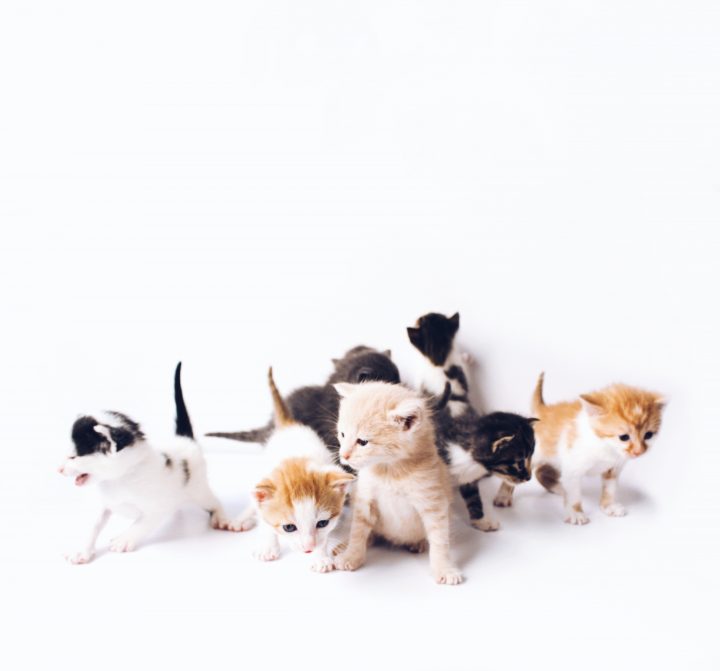
Cat Giving Birth for the First Time? Stay Calm; It’ll Be OK!
If your cat is getting ready to give birth for the first time, it is understandable that you are concerned and want to know how you can support her.
Thankfully, cats have a maternal instinct that will kick in during their pregnancy. This will help them deliver and care for their kittens.
Stay close by and monitor your cat, but in most cases they know what to do.
If you are concerned that something is wrong, though, don’t hesitate to reach out to your vet.
FAQs
In most cases, you should leave your cat alone while they are giving birth. For the most part, most female cats want to give birth in a quiet and safe spot where they can be alone. However, be sure to check in from time to time to monitor the situation and make sure everything is going well.
Some signs that your cat is about to go into labor include a decreased body temperature, displaying nesting behaviors, an increase in the size of the mammary glands, loss of appetite, changes in behavior, howling, pacing, and chirping.
Cat giving birth for the first time how long? If your cat is in labor for the first time, it may take up to 36 or 42 hours for her to deliver a litter of kittens. Subsequent pregnancies may have a decreased labor time, with the average being around 16 hours.
Cat pregnancies typically last for 58 to 67 days. The average labor length is 16 hours. However, some cats may be finished in as little as 4 hours or as many as 42 hours.
While a cat’s average litter size is between 4 and 6 kittens, the first litter is often smaller. Typically, there will be between 2 and 3 kittens in a cat’s first litter.




